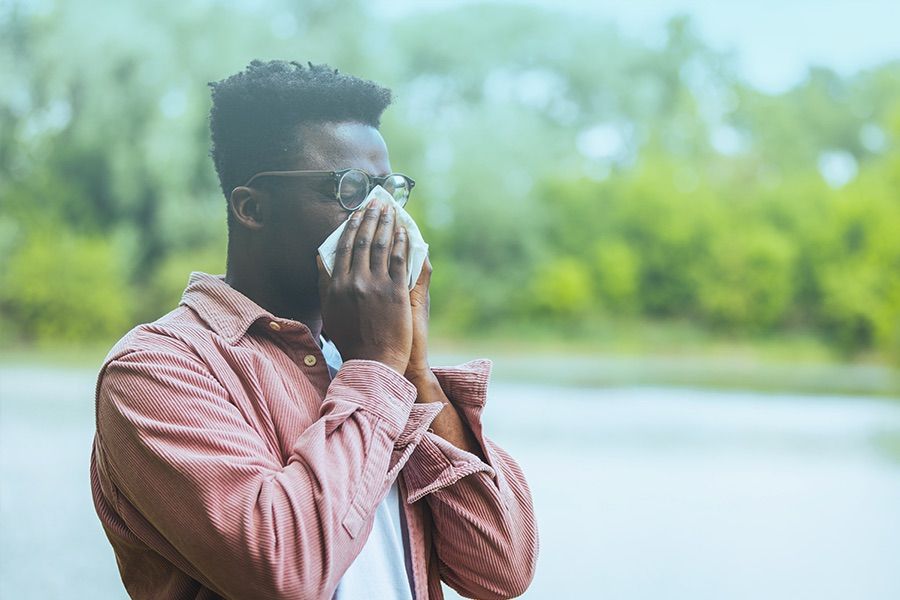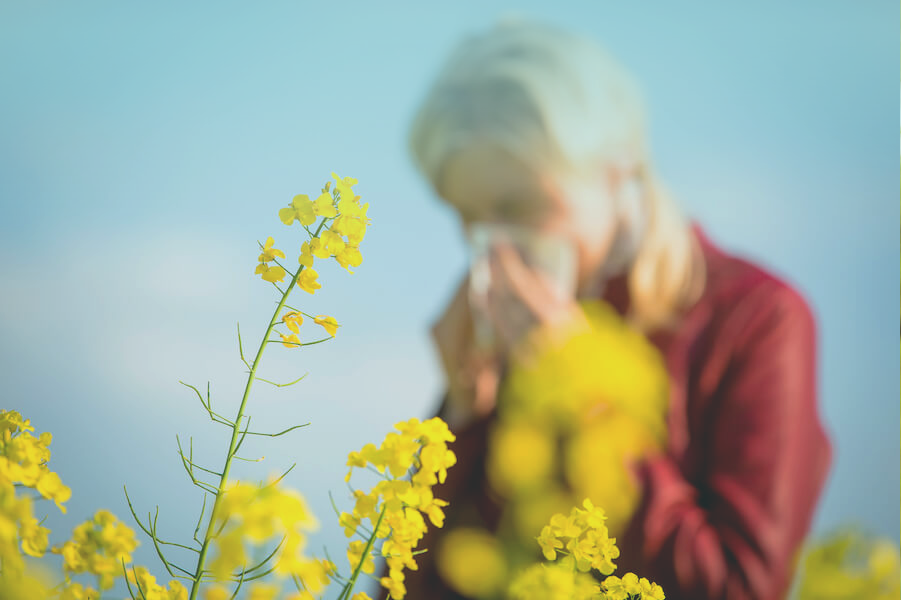Breathe Freely

Seasonal Allergy Trends: What Data Tells Us
Seasonal allergies can be uncomfortable and just downright annoying. Learn more about what affects our seasonal allergies and the best ways to treat them.
It’s that time of year! Allergy season is upon us once again.
Seasonal allergies are an extremely common condition, affecting millions of people around the world. These allergy symptoms occur when the immune system overreacts to pollen, mold spores, or other allergens that are present in the air during certain times of the year. While spring and summer tend to be the most popular times for seasonal allergies, allergens are everywhere and can affect you in any season.
Seasonal allergies can be extremely debilitating. With symptoms like itchy eyes, sneezing, congestion, and fatigue, it can feel nearly impossible to get anything done. In this blog, we’ll explore the impact of seasonal allergies, what contributes to them, the best treatment options, and so much more.
Keep reading to learn more — or connect with us directly if you’re ready to treat your allergy symptoms with Quello’s safe and convenient allergy drops!
The Most Common Seasonal Allergies

Pollen
Pollen is one of the most common allergens in the world, and it triggers seasonal allergies in people of all ages.
Pollen, which is typically released into the air during the warmer spring and summer months, is a powder produced by plants during their reproductive cycle. Pollen grains are lightweight and can travel long distances through the air, making it easy for them to enter the respiratory system. This triggers the immune response that we all recognize as allergies.
In 2021, approximately 81 million people in the U.S. were diagnosed with seasonal allergic rhinitis (also known as hay fever). Breaking this statistic down further, 26% (67 million) of these people were adults and 19% (14 million) were children.
So, why does pollen cause allergies to flare up? Simply put, it’s a case of mistaken identity. If you suffer from allergies, your immune system mistakes pollen as a harmful invader and releases antibodies to fight it off. As your immune response builds, you’ll begin to experience those all-too-familiar symptoms: sneezing, swelling, watery eyes, and more.
The severity of the symptoms can vary depending on the type of pollen and your individual sensitivity to it. Due to the widespread presence of pollen in the environment, it’s crucial for people with allergies to take appropriate measures to manage their symptoms during peak pollen seasons (more on that later!)
Dust Mites
Dust mites are the second most common seasonal allergy trigger. These mites are microscopic organisms that thrive in warm, humid environments such as bedding, carpets, and upholstery. They can be prevalent all year round but can be particularly problematic during the winter months when people spend more time indoors with their windows closed.
While dust mites don’t cause any abnormal seasonal allergy symptoms, people who are allergic to dust mites may also experience asthma symptoms like coughing and wheezing. In order to manage and eliminate dust mites, it’s crucial that you keep indoor environments clean and dry and use allergen-proof covers on all bedding and pillows. Regularly vacuuming and dusting can also help to reduce dust mite populations in the home.
Mold Spores
Mold spores are another common allergen that can give rise to seasonal allergy symptoms. Unlike other allergens like pollen, mold is more likely to be seen year-round and can even be more prominent in the fall.
Mold is a type of fungus that grows in damp environments and can be found both indoors and outdoors. Specifically, in the fall season, mold spores are released into the air when leaves and other plant materials begin to decay, which then triggers allergic reactions.
These tiny mold particles can easily enter the respiratory system and cause an immune response in people with allergies. The symptoms of mold allergies are similar to those of other seasonal allergies and include sneezing, runny nose, itchy eyes and throat, and more.
People who are allergic to mold may also experience asthma symptoms on top of their normal allergy symptoms. To manage mold allergies, it is important to keep indoor environments clean, dry, and well-ventilated to eliminate the potential for mold growth. You’ll also want to avoid outdoor mold by steering clear of damp areas such as marshes and gardens during those peak seasons
Recent Seasonal Allergy Trends
Allergy trends are tracked and reported by various organizations and agencies, including the American Academy of Allergy, Asthma, and Immunology (AAAAI) and the Centers for Disease Control and Prevention (CDC). They collect data from surveys and studies to determine the prevalence and severity of allergies in different regions and populations.
In recent years, there has been a significant increase in seasonal allergies all over the world, with more people experiencing symptoms than ever before. Experts attribute this trend to environmental factors such as climate change, increased air pollution, and changes in plant and tree species.
Regional variations also exist. Some areas are experiencing more severe allergy seasons than others due to factors such as changes in local vegetation and weather patterns. While the increase in seasonal allergies may be of concern, there is ongoing research and development of new treatments and management strategies to help allergy sufferers cope with their symptoms.

Here are some of the most recent data about seasonal allergies:
- Nearly 1 in 3 U.S. adults and more than 1 in 4 U.S. children reported having a seasonal allergy, eczema, or food allergy in 2021, according to new data from the CDC's National Center for Health Statistics.
- According to a study published in the Journal of Allergy and Clinical Immunology in 2021, the prevalence of allergic rhinitis (seasonal allergies) in the United States increased from 26.5% in 2005 to 33.2% in 2019.
- The Asthma and Allergy Foundation of America reports that over 60 million Americans suffer from allergies each year.
- A study published in the journal Environmental Health Perspectives in 2020 found that climate change is causing pollen seasons to start earlier and last longer, leading to increased exposure to allergens.
What Contributes to Seasonal Allergies?
Climate Change

Climate change is one of the biggest influences when it comes to seasonal allergy trends. Rising global temperatures can speed up the process of growth for pollen, mold, and other allergens. Many areas have also been experiencing longer periods of warm weather, which allows these allergens to proliferate even more than they did just a few years ago.
Overall, the effects of climate change are leading to a more intense and prolonged allergy season, making it harder for people with seasonal allergies to manage their symptoms.
Weather Patterns

Weather patterns are also a major contributor to seasonal allergy trends.
Strong, heavy winds can blow pollen and other weeds into new areas. Similarly, increased rain causes plants to grow faster and stronger, allowing them to expel more pollen. Changes in humidity can also affect how fast mold grows. All in all, these weather patterns can make the normal allergy season much longer and more intense.
Air Pollution

Air pollution is another strong contributor to seasonal allergies. Exposure to air pollutants like carbon monoxide, lead, and particulate matter can irritate the respiratory system and trigger your normal allergy response. Depending on how strong the pollutants are in that area, it can even make allergy symptoms worse.
Air pollution varies based on where a person lives. While some degree of air pollution is almost impossible to avoid, people who live in urban areas, near major highways, or near large factory plants are more likely to experience the effects of air pollution on their seasonal allergies. You can reduce your exposure to air pollution by using air purifiers, avoiding outdoor activity during high pollution days, and doing your best to stay off of busy city streets.
Lifestyle Changes

One of the most interesting aspects when it comes to increased seasonal allergies has come from the various lifestyle changes we have adopted during the COVID-19 pandemic. From lockdown and spending more time indoors to remote work and online availability on the rise, we are spending more time in our homes than we did in years past.
While spending extra time at home has its perks, it also comes with a downside: dust and other allergens are more likely to gather, especially if you’re not cleaning your home regularly. In order to combat allergens, you’ll want to make sure that you’re following these steps:
- Regularly vacuuming and dusting
- Regularly washing sheets and bedding in hot water
- Changing out air filters every season, or at least twice per year
- Using an air purifier
- Limiting time with open windows and doors
What is the Best Way to Treat Seasonal Allergies?
Immunotherapy
Immunotherapy is the best way to treat seasonal allergies.
Allergy shots and allergy drops are the two most popular types of immunotherapy. Both of these treatments involve gradually exposing the immune system to small amounts of allergens. This process helps the immune system build up a tolerance to the specific allergen and reduces the severity of allergy symptoms over time.

Allergy Shots
Allergy shots are typically administered by a healthcare provider — usually once or twice per week during the “buildup” phase and once per month during the “maintenance” phase. Often, the dosage of the allergen within the shot increases over time.
Allergy shots can be a great option for building long-term tolerance, but there are certainly some downsides. Many people struggle with a fear of needles and find the shots to be painful. It can also be difficult to keep up with scheduling, as you would need to receive these shots in person each week.
Allergy Drops
Allergy drops, like the ones we offer at Quello, are a type of immunotherapy that involves placing drops of a solution containing small amounts of allergens under the tongue. This treatment is similar to allergy shots but can be administered at home, making it a more convenient option for some individuals. Allergy drops are usually taken daily and gradually increase in dosage over the span of several months.
Allergy drops, also known as sublingual immunotherapy, work similarly to allergy shots. However, allergy drops don’t require any needles or regularly-scheduled visits — you can simply take them each day from the comfort of your home.
At-Home Remedies
While immunotherapy is the most effective treatment for seasonal allergies, there are also several at-home remedies that people can try to alleviate their symptoms. One of the most effective at-home remedies is nasal saline irrigation, more commonly known as a neti pot. This involves using a saline solution to flush out the nasal passages, which helps to remove allergens and irritants. You can also try steam inhalation, using a humidifier, and applying warm compresses to your face to help alleviate congestion and sinus pressure.
It’s important to keep in mind that at-home remedies aren’t a perfect substitute for medical treatment. If you’re still struggling with your allergy symptoms after exhausting your at-home options, it may be time to speak with an allergy specialist!
Rid Yourself of Seasonal Allergies for Good
Seasonal allergies are a frustrating experience for many people, but they don't have to be! Quello allergy drops are personalized drops that are tailored to your specific allergy triggers, providing an effective way to manage allergies and improve your quality of life. Quello drops are easy to use, safe, and can be taken from the comfort of your own home.
If you are ready to take control of your seasonal allergies, Quello is here for you.

Overcome your allergies at home with our doctor-led therapy.
Get started with our free allergy test kitGet Started with no test needed.
Overcome your allergies at home with our doctor-led therapy.
Get started with our free allergy test kitGet Started with no test needed.

